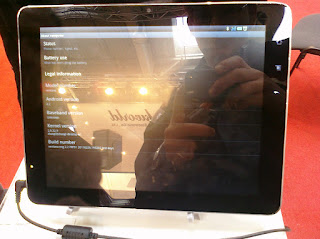I am still about to get a tablet, and every time a new cheap tablet pops up, I am considering it because I like to make a bargain. Of course, a cheaper tablet always lacks some features when compared to a more expensive one – be it the brand or more. If you are considering cheap tablets, you are apparently not too much about brands, and if you are willing to import such a device, you shouldn´t care about warranty. Often there are some more features that aren´t quite as good as with the more expensive alternative: These are CPU / GPU performance, amount of RAM, weight, touch screen quality, 3G, battery life – if the, say, china tablet not made/sold by a top brand at a drastically lower price, you have to expect one or more of the named features being inferior.
 |
| Pierre Cardin PC1018 9.7” Tegra2 tablet |
Independent of your usage case, you shouldn´t go for an Android tablet that has specs inferior to: 500+MHz ARM11 CPU, 256MB Ram, WiFi, Android 2.1 – as battery life is usually not on the average spec sheet (or mentioned for fictional usage cases), and weight varies depending on the form factor, I don´t give you numbers here. Of course, tablets may still work for you, if you just want to use them as a digital picture frame or an e-reader – but still, it won´t be fun to use them as build quality will be most likely crap, too.
If you want to use your tablet for the web, you might need Flash for a full web experience. If you want to have a good Flash experience, with Flash 10.1 for Android, you will need a tablet that has an ARMv7 (ARM Cortex A8, ARM Cortex A9) SoC and runs Android 2.2 (Froyo) – and if you want to play safe and have a snazzy device, 512MB RAM are better for you (a device like this one shows that this doesn´t mean you´ll have to pay a fortune).
But then, again, great specs don´t make a great tablet user experience yet. At the Pierre Cardin booth at CeBIT I was told that their Froyo running 9.7” Tegra2 tablet has a battery life of 3-4 hours – which is way inferior to what brands like Samsung, Motorola, LG or Apple offer. You may argue, that Froyo isn´t optimized for Tegra2 devices – and you are damn right, Honeycomb is Tegra2 optimized and may increase battery life, but still: You can´t tell when you´ll get Honeycomb on your cheap Tegra2 (or in general dual core ARM) device – though unfortunately you can´t be sure of fast Android updates on your top brand (tablet) device, anyway.
Still, it all depends on your usage case. Most of us don´t really know what their use case of a new device class is. So get a cheap device or a more expensive one that you can return to find this out – and then make your decision.